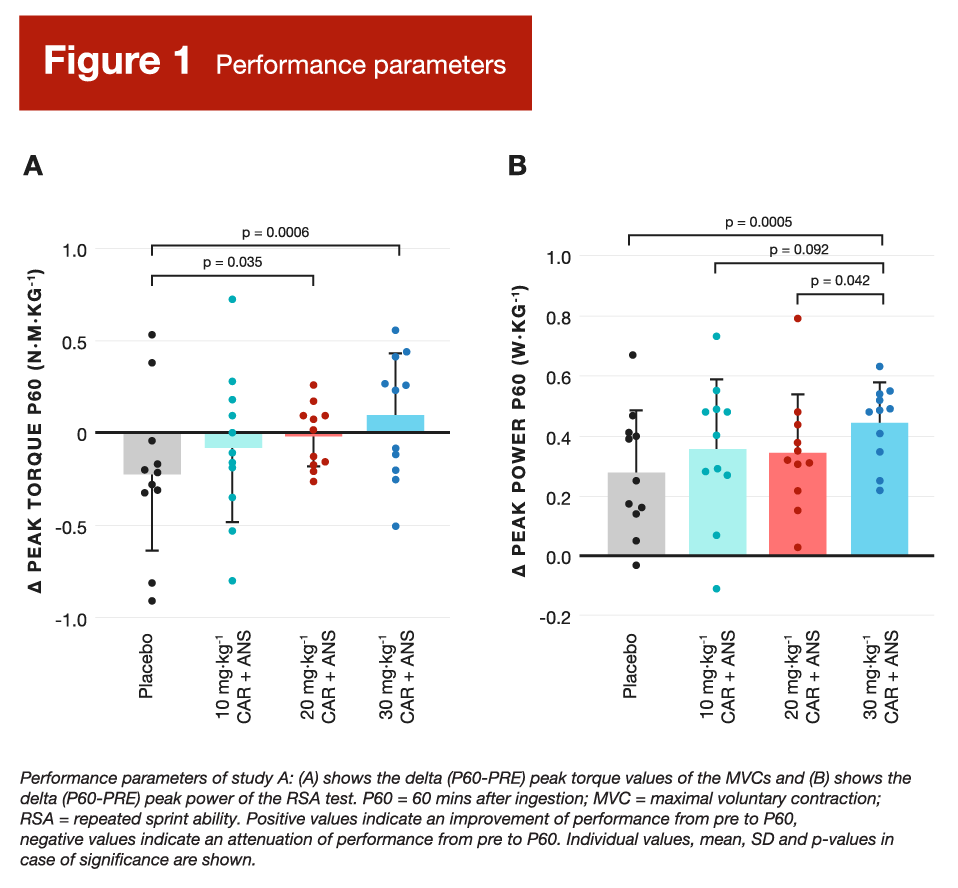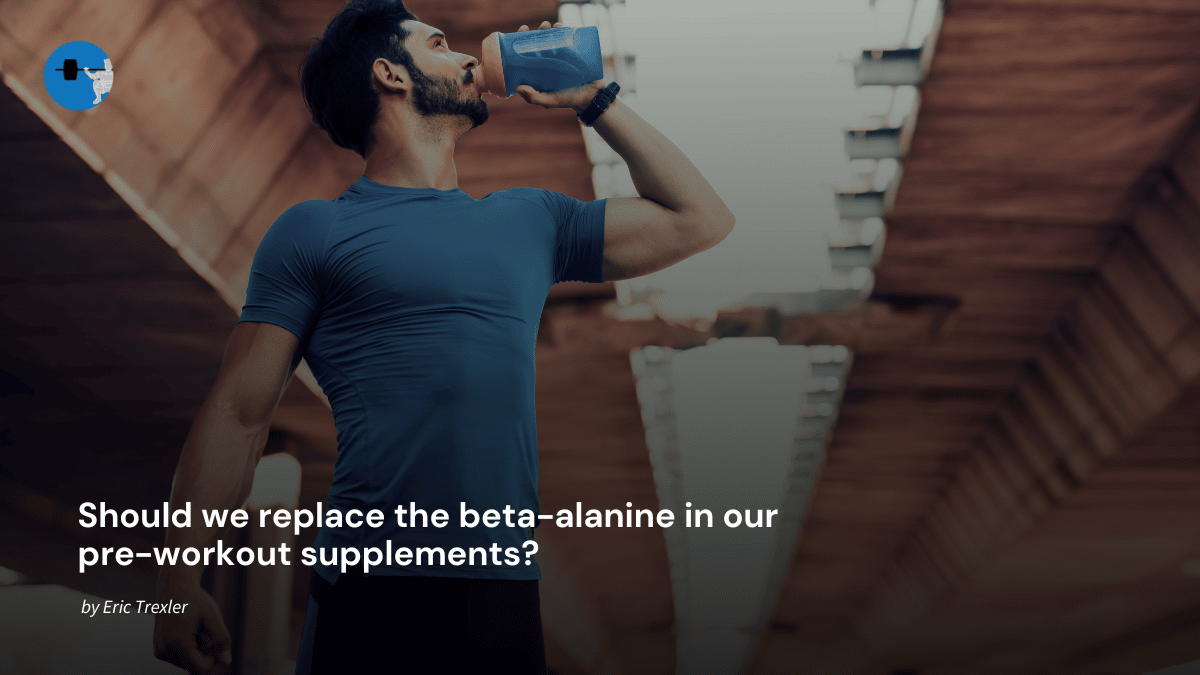Beta-alanine is a well-known dietary supplement, and one of the most commonly used ingredients in multi-ingredient pre-workout supplements. However, beta-alanine isn’t really the star of the show, despite the attention it continues to receive in the supplement world. In reality, beta-alanine works by increasing intramuscular levels of carnosine, which is formed by combining histidine and beta-alanine. When intramuscular carnosine levels are high, we’re more able to attenuate reductions in pH as excess hydrogen ions start to accumulate during high-intensity exercise, which delays fatigue. Direct supplementation with carnosine is often overlooked because human blood contains high levels of the carnosinase-1 enzyme, which rapidly breaks down carnosine to its constituent components (histidine and beta-alanine). As a result, the oral bioavailability for oral carnosine supplementation is quite poor. Beta-alanine is the rate-limiting component enabling intramuscular carnosine synthesis, so it has intuitively become the supplement option of choice.
With this mechanism of action in mind, I find it very interesting that beta-alanine has become a staple ingredient in pre-workout supplements. Beta-alanine is researched almost exclusively within the context of chronic supplementation (with 4-7g/day) to increase muscle carnosine levels over a span of several weeks, yet its most common application is 1-3g doses taken on training days only. It’s hard to suggest that there’s a noteworthy acute effect from beta-alanine supplementation, but it’s also very hard to suggest that a couple grams before workouts is going to come anywhere close to maximizing intramuscular carnosine levels over time. As a result, a new carnosine-related supplement strategy has emerged, and preliminary evidence is starting to roll in.
I’m starting to see more and more studies investigating the acute impact of combined supplementation with carnosine and a methylated carnosine analogue called anserine, which are both considered “histidine-containing dipeptides.” Histidine-containing dipeptides are predominantly found in muscle and neuronal tissue, but also exist in the heart, liver, and kidneys of mammals. All mammals have both carnosine and a methylated carnosine analogue (such as anserine) in their skeletal muscle tissue, with one exception – Homo sapiens. We humans have carnosine as our sole intramuscular histidine-containing dipeptide (that is, with no methylated analogues), with substantially higher carnosine concentrations in fast-twitch fibers than slow-twitch fibers.
At this point, we’ve covered three main points: the effects of beta-alanine are chronic (not acute), oral carnosine has poor bioavailability, and humans don’t have anserine in their muscle tissue. It seems like we’re out of options for acute, pre-workout supplementation strategies, but there’s some good news – anserine is less susceptible to breakdown by the carnosinase-1 enzyme. This has given rise to a fairly novel combination strategy, whereby carnosine is supplemented to saturate the carnosinase-1 enzyme, and anserine is supplemented to circumvent the carnosinase-1 enzyme. The result, in theory, is high circulating levels of histidine-containing dipeptides, which should provide an ergogenic effect during high-intensity exercise.
The presently reviewed study involved a series of three experiments that aimed “to establish dosing and timing guidelines concerning carnosine and anserine intake and to unravel the mechanism underlying the ergogenic effects.” A detailed rundown of three separate experiments is a bit excessive for a research brief, so I’ll just hit the highlights. In the first experiment, 11 men completed four different study conditions: 10mg/kg, 20mg/kg, or 30mg/kg each of carnosine and anserine, or a placebo (providing 0mg/kg of body mass), provided prior to exercise bouts occurring 30min and 60min after supplement ingestion. Performance was assessed by testing maximal isometric leg extension torque and power output during a repeated sprint test involving five, 6-second cycle sprints with maximal effort. Results suggested that 60min supplement timing was clearly more favorable than 30min supplement timing. Furthermore, when looking at the performance outcomes at 60min post-ingestion, it was clear that higher doses led to more favorable performance outcomes. At the highest dose (30mg/kg each of carnosine and anserine), supplementation led to statistically significant improvements in isometric leg extension torque (+3%) and peak power during the repeated sprint test (+4.5%; Figure 1).

The other two experiments were more focused on exploring nuanced mechanisms; due to limited potential for practical applications, I’ll summarize them as concisely as possible. In order to explore the possibility of increased neuromuscular function, one experiment had fifteen men complete a test protocol involving maximal isometric leg extensions with simultaneous nerve stimulation to evoke maximal force production, followed by a repeated sprint test (again, five, 6-second cycling sprints). In this experiment, exercise testing was completed before supplementation and 60min after. Results of this second experiment failed to find any supplement-induced alterations in several different parameters of neuromuscular function, nor did they observe any ergogenic effects. However, when looking at this experiment alone (or combining data from the first and second experiments), they found a significant inverse relationship between carnosinase enzyme activity and performance improvements. In other words, people with lower carnosinase enzyme activity enjoyed larger and more sustained increases in plasma concentrations of histidine-containing dipeptides, which conferred more pronounced ergogenic effects.
Finally, the third experiment explored a potential mechanism related to increased muscle blood flow and tissue perfusion following supplementation. In short, their findings were not consistent with this potential mechanism playing an important, causative role in promoting the observed ergogenic effects. So, in summary, the researchers found that 30mg/kg each of carnosine and anserine increased circulation concentrations of histidine-containing dipeptides, which led to some ergogenic effects during high-intensity exercise. They also determined that there is an incremental dose-response relationship between supplement dose and performance improvement, and concluded that the minimum effect dose is likely in the 40-60mg/kg range (that is, 40-60mg/kg of each). In addition, their data suggest that supplementation should occur 60 (rather than 30) minutes before exercise, and that individuals with lower carnosinase enzyme activity are likely to enjoy more pronounced ergogenic effects (at least within the dosage range that was tested). Finally, the data did not seem to suggest that alterations in neuromuscular function or tissue perfusion were driving the observed performance enhancements.
This might seem like a cutting-edge finding, but it’s actually not the first study to report that combined carnosine and anserine supplementation either influenced buffering capacity during exercise or enhanced performance. The first such studies actually used chicken broth as the supplement of choice, which provides carnosine and anserine in a ratio that ranges from approximately 1:2 to 1:3. Suzuki published a pair of studies on chicken broth back in 2004 and 2006; the first study reported improvements in repeated sprint performance, while the second only found improvements in buffering capacity (but no significant change in performance outcomes). More recently, a 2021 study found that chicken broth enhanced 8-minute time trial performance, but did not significantly alter acid-base balance during exercise. Finally, the researchers who published the presently reviewed study also reported some performance improvements in a 2021 paper, which found that combined carnosine and anserine (in capsule form) enhanced power output during high-intensity cycle sprints.
In summary, this research is very preliminary, but you could make the mechanistic argument that the combination of carnosine and anserine makes more sense than beta-alanine in the context of pre-workout supplements that are intended to induce acute effects. I’ll be keeping an eye on this literature as it develops, and I’ll be interested to see if any supplement companies start working these ingredients into pre-workout formulas. At this point in time, the best estimate for optimal dosing strategies involve taking 40-60 mg/kg of each, approximately one hour prior to exercise. For now, eager supplement experimenters might run into some challenges, as anserine doesn’t seem easy to come by in powder or capsule form. However, chicken broth is always available; previous studies have reported ergogenic effects with around 8 mL/kg, which should yield around 46.4 mg/kg of total histidine-containing dipeptides. Having said that, the presently reviewed study suggests that the optimal dose may be twice that large, if not larger. So, it might be a bit challenging to apply these findings right away, but it’ll certainly be an interesting area of research to watch.
Note: This article was published in partnership with MASS Research Review. Full versions of Research Spotlight breakdowns are originally published in MASS Research Review. Subscribe to MASS to get a monthly publication with breakdowns of recent exercise and nutrition studies.




